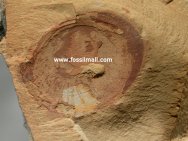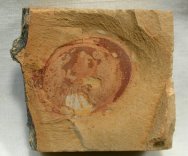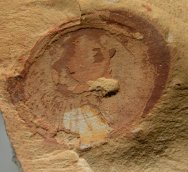Heliomedusa
orienta
Phylum Brachiopoda
Geological
Time: Early Cambrian (~525 million years ago)
Size: 14
mm by 18 mm
Fossil
Site: Chengjiang Maotianshan Shales, Quiongzhusi Section, Yu’anshan
Member, Heilinpu Formation, Haiyi Village, Anning, Kunming County, Yunnan
Province, China
|  Description:
This brachiopod is known as Heliomedusa orienta. The species is
a relatively common member of the Chengjiang biota. The source of
the specific name is easy to determine, but the reason is that the
oval shape and redial patterning led the original describers to
think it was a jellyfish.. The diversity of soft-tissue fossils
is astonishing: algae, medusiforms, sponges, priapulids, annelid-like
worms, echinoderms, arthropods (including trilobites), hemichordates,
chordates, and the first agnathan fish make up just a small fraction
of the total. Numerous problematic forms are known as well, some
of which may have represented failed attempts at diversity that
did not persist to the present day. Unlike most brachiopods, Heliomedusa
lacked a pedicle, leading scientists to believe it lay upon the
surface of the sediment as an epifaunal filter feeder. Notice the
fringe of stae thought to have served a sensory function. While
the taxon had a widespread distribution throughout eastern Yunnan
Province, this one comes from the most famous Chengjiang Biota locale:
Mao Tian Hill, site of the original discovery. Description:
This brachiopod is known as Heliomedusa orienta. The species is
a relatively common member of the Chengjiang biota. The source of
the specific name is easy to determine, but the reason is that the
oval shape and redial patterning led the original describers to
think it was a jellyfish.. The diversity of soft-tissue fossils
is astonishing: algae, medusiforms, sponges, priapulids, annelid-like
worms, echinoderms, arthropods (including trilobites), hemichordates,
chordates, and the first agnathan fish make up just a small fraction
of the total. Numerous problematic forms are known as well, some
of which may have represented failed attempts at diversity that
did not persist to the present day. Unlike most brachiopods, Heliomedusa
lacked a pedicle, leading scientists to believe it lay upon the
surface of the sediment as an epifaunal filter feeder. Notice the
fringe of stae thought to have served a sensory function. While
the taxon had a widespread distribution throughout eastern Yunnan
Province, this one comes from the most famous Chengjiang Biota locale:
Mao Tian Hill, site of the original discovery.
|
|


